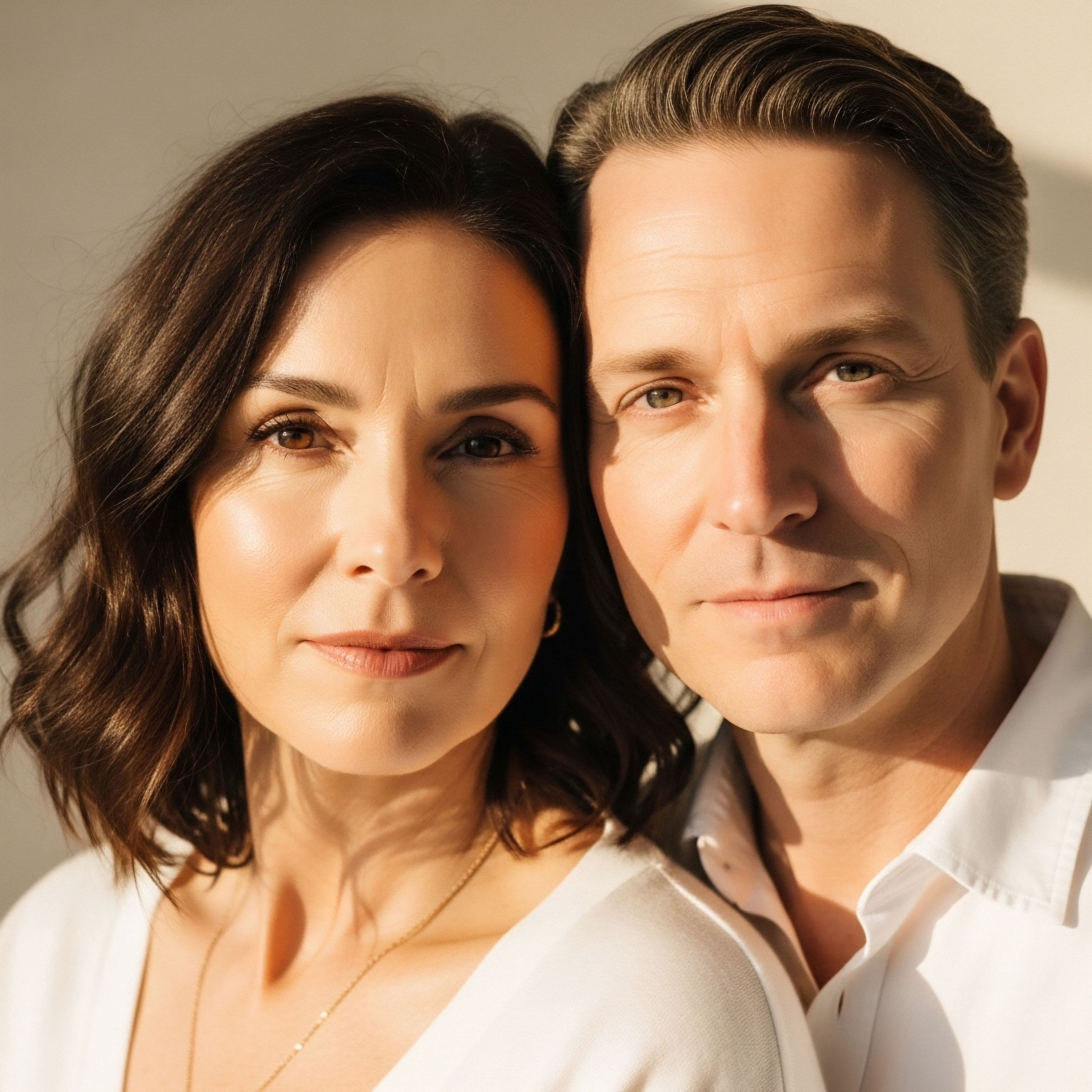

Fundamentals
You feel it before you can name it. A subtle shift in energy, a change in your sleep, a mood that feels untethered from your daily life. When you begin a protocol of hormonal support, whether it’s Testosterone Replacement Therapy (TRT) for andropause or a carefully calibrated combination of hormones for perimenopause, the expectation is one of restoration.
You anticipate a return to a state of vitality that feels familiar. The prescribed molecules ∞ Testosterone Cypionate, Progesterone, Gonadorelin ∞ are precise tools designed to replenish what has been lost. Their primary function is to bind to specific receptors on your cells, initiating a cascade of biological signals that govern everything from muscle synthesis to cognitive clarity. This is the direct, biochemical action of the therapy.
The effectiveness of these protocols is profoundly shaped by the biological environment in which they operate. Your body is a dynamic system, a complex interplay of signals and pathways. Hormonal support introduces a powerful new signal, yet its clarity and impact are either amplified or muffled by the background noise of your daily life.
Your lifestyle choices are the primary modulators of this internal environment. They dictate the sensitivity of your cellular receptors, the efficiency of your metabolic pathways, and the baseline level of inflammation that can interfere with hormonal signaling. These daily inputs determine whether the therapeutic hormones you introduce can effectively dock with their intended cellular targets and execute their functions without impedance. This is the foundational principle ∞ the medicine provides the signal, but your lifestyle prepares the system to receive it.
The daily choices you make directly influence your body’s ability to utilize hormonal support, determining whether the therapy achieves its full potential.
Consider the architecture of your endocrine system. It is not a collection of isolated glands but a deeply interconnected network, with the Hypothalamic-Pituitary-Gonadal (HPG) axis serving as a central command center. This axis is exquisitely sensitive to external inputs.
Chronic stress, for instance, elevates cortisol, a hormone that can interfere with the function of both testosterone and progesterone. Inadequate sleep disrupts the pulsatile release of luteinizing hormone (LH) from the pituitary gland, a critical signal for natural testosterone production, which can complicate the calibration of therapies that include agents like Gonadorelin.
These are not minor interferences; they are significant biological events that can alter the very foundation upon which your hormonal protocol is built. Your lifestyle is, in essence, a constant conversation with your endocrine system, and the quality of that conversation dictates the outcome of any therapeutic intervention.


Intermediate
To appreciate how lifestyle modulates hormonal optimization, we must examine the specific mechanisms at the cellular and systemic levels. The prescribed therapies, such as weekly injections of Testosterone Cypionate, are designed to establish stable, therapeutic levels of hormones in the bloodstream.
The journey from the bloodstream to a tangible biological effect, however, depends on a series of lifestyle-dependent checkpoints. These checkpoints determine the bioavailability of the hormone, the sensitivity of its target receptors, and the efficiency of its downstream signaling pathways. A failure at any of these points can lead to a suboptimal response, even with a clinically appropriate dosage.

Metabolic Health as the Endocrine Foundation
One of the most significant modulators of hormonal therapy effectiveness is metabolic health, specifically insulin sensitivity. Insulin resistance, a condition where cells become less responsive to the effects of insulin, creates a state of systemic inflammation and metabolic dysfunction that directly impacts sex hormone signaling.
In men undergoing TRT, for example, insulin resistance can be both a contributing factor to low testosterone and a barrier to the therapy’s success. Studies have shown that testosterone therapy can improve insulin sensitivity, but the relationship is bidirectional. A lifestyle characterized by a diet high in processed carbohydrates and a lack of physical activity perpetuates insulin resistance, which can blunt the benefits of TRT on body composition and energy levels.
For women, particularly during perimenopause and post-menopause, the interplay between insulin and sex hormones is equally critical. Insulin resistance can exacerbate the symptoms of hormonal decline, such as weight gain and mood instability. When a woman begins a protocol that may include low-dose testosterone and progesterone, her underlying metabolic state will significantly influence the outcomes.
Progesterone, for instance, has a complex relationship with insulin and glucose metabolism. A state of high insulin can interfere with progesterone’s calming effects and contribute to the very symptoms the therapy aims to alleviate.
Your metabolic health, particularly your level of insulin sensitivity, acts as a critical gatekeeper for the effectiveness of hormonal therapies.

The Role of Adipose Tissue and Aromatase
Body composition, a direct consequence of diet and exercise, plays a pivotal role in hormonal balance, primarily through the activity of an enzyme called aromatase. Aromatase is responsible for converting androgens, like testosterone, into estrogens. Adipose tissue, or body fat, is a primary site of aromatase activity. In both men and women, excess body fat leads to increased aromatase activity, resulting in a higher conversion of testosterone to estradiol.
For a man on TRT, this can be counterproductive. The therapeutic testosterone intended to alleviate symptoms of hypogonadism can be excessively converted to estrogen, potentially leading to side effects such as gynecomastia and water retention. This is why protocols often include an aromatase inhibitor like Anastrozole.
A lifestyle that promotes lean body mass through resistance training and a nutrient-dense diet can naturally reduce aromatase activity, making the TRT protocol more efficient and potentially reducing the need for ancillary medications. For women, while estrogen is necessary, an imbalanced ratio of estrogen to progesterone due to excess aromatization can contribute to symptoms of estrogen dominance, even while on a balanced hormonal support protocol.
- Dietary Influence A diet rich in phytonutrients and healthy fats can help modulate inflammation, which is linked to aromatase expression. Processed foods and excessive sugar intake can promote inflammation and, consequently, aromatase activity.
- Exercise and Body Composition Resistance training is particularly effective at increasing muscle mass and reducing body fat, thereby decreasing the primary site of aromatase conversion.

How Does Stress Directly Sabotage Hormone Protocols?
The body’s stress response system, governed by the Hypothalamic-Pituitary-Adrenal (HPA) axis, has a profound and often antagonistic relationship with the HPG axis. Chronic stress leads to sustained high levels of cortisol, which can create significant interference for hormonal therapies.
One of the most direct forms of interference is known as “progesterone steal.” Progesterone and cortisol are synthesized from the same precursor hormone, pregnenolone. When the body is under chronic stress, the demand for cortisol production becomes a priority. This can divert pregnenolone away from the pathway that produces progesterone, leading to lower levels of this crucial hormone.
For a woman on a progesterone protocol for menopausal symptoms, chronic stress can effectively work against the therapy, depleting the very hormone she is trying to supplement. For men, while the effect is less direct, the overall systemic stress and inflammation caused by high cortisol can blunt the anabolic and cognitive benefits of testosterone.
| Hormone | Mechanism of Interference | Clinical Implication |
|---|---|---|
| Progesterone | Cortisol production is prioritized, diverting the precursor pregnenolone away from progesterone synthesis. | Reduces the effectiveness of supplemental progesterone, potentially leading to continued symptoms of anxiety and poor sleep. |
| Testosterone | High cortisol levels can suppress the HPG axis, reducing endogenous testosterone production and creating a more catabolic systemic environment. | Blunts the anabolic effects of TRT, such as muscle gain and fat loss, and can interfere with mood and libido improvements. |


Academic
A sophisticated understanding of how lifestyle influences hormonal support protocols requires a deep dive into the molecular biology of cellular receptors and the systemic interplay of endocrine axes. The administration of exogenous hormones like Testosterone Cypionate or bioidentical Progesterone initiates a therapeutic signal.
The fidelity and ultimate physiological impact of this signal are contingent upon a complex set of variables that are directly and powerfully modulated by lifestyle inputs. These inputs do not merely support the therapy; they are integral components of the therapeutic outcome itself, capable of dictating receptor density, gene transcription, and the metabolic fate of the hormones administered.

The Central Role of Androgen Receptor Sensitivity
The biological action of testosterone is mediated by the androgen receptor (AR), a protein found within target cells in muscle, bone, brain, and other tissues. The effectiveness of TRT is a function of both the circulating level of testosterone and the density and sensitivity of these androgen receptors.
A patient can have therapeutic levels of testosterone in their serum, but if AR density is low or the receptors are insensitive, the clinical response will be attenuated. Lifestyle factors, particularly exercise, are potent modulators of AR expression and sensitivity.
Resistance exercise, specifically high-load training, has been shown to increase AR-DNA binding activity in skeletal muscle. This suggests that the mechanical stress and metabolic demand of weight training upregulate the machinery that allows testosterone to exert its anabolic effects.
The exercise-induced increase in AR sensitivity means that for a given level of circulating testosterone, the signal for muscle protein synthesis is amplified. This provides a clear, evidence-based rationale for the inclusion of resistance training as a non-negotiable component of a successful TRT protocol. It transforms the therapy from a simple act of hormone replacement into a synergistic process of tissue-specific signal amplification.
The sensitivity and density of cellular hormone receptors, which are heavily influenced by exercise and metabolic health, are the final arbiters of a hormonal therapy’s success.

The Hypothalamic-Pituitary-Gonadal Axis and Sleep Architecture
The integrity of the Hypothalamic-Pituitary-Gonadal (HPG) axis is fundamental to endocrine health. While hormonal support protocols can supplement downstream hormones, the central regulatory mechanisms of the HPG axis remain profoundly influenced by lifestyle. Sleep is a critical regulator of this axis.
Deep sleep, or slow-wave sleep, is when the pituitary gland releases growth hormone and modulates the release of gonadotropin-releasing hormone (GnRH), which in turn stimulates the release of luteinizing hormone (LH) and follicle-stimulating hormone (FSH).
Sleep deprivation has been demonstrated to cause a state of pituitary hypogonadism, characterized by a marked decrease in LH levels and a subsequent reduction in endogenous testosterone production. For a male patient on a TRT protocol that includes Gonadorelin, a GnRH analogue designed to maintain testicular function by stimulating LH release, chronic sleep deprivation can create a state of pituitary resistance to the drug’s signal.
The sleep-deprived state is also associated with elevated cortisol levels, further suppressing the HPG axis. This illustrates a critical point ∞ lifestyle factors can induce a state of functional resistance to the very medications designed to support the endocrine system.

What Is the Bio-Regulatory Impact of Stress on Progesterone Efficacy?
The interaction between cortisol and progesterone extends beyond the simple competition for the precursor pregnenolone. Cortisol can also exert a direct antagonistic effect at the receptor level. Both cortisol and progesterone are steroid hormones and share some structural similarities.
Under conditions of chronic stress and sustained high cortisol levels, cortisol can bind to progesterone receptors, albeit with lower affinity than progesterone itself. This competitive binding can effectively block progesterone from docking with its own receptors, preventing it from carrying out its intended functions, such as promoting calmness, improving sleep quality, and balancing the effects of estrogen.
This mechanism of receptor antagonism means that even if a woman is taking a therapeutic dose of progesterone, high levels of stress-induced cortisol can render a significant portion of that dose ineffective. The clinical picture would be one of persistent symptoms despite seemingly adequate hormonal supplementation.
This underscores the necessity of integrating stress management techniques, such as mindfulness, meditation, or yoga, into a comprehensive hormonal wellness plan. These are not ancillary recommendations; they are evidence-based interventions designed to lower cortisol and restore the sensitivity of progesterone receptors, thereby allowing the therapeutic protocol to function as intended.
| Lifestyle Factor | Molecular Mechanism | Impact on Hormonal Protocol |
|---|---|---|
| Resistance Exercise | Increases androgen receptor (AR) density and AR-DNA binding activity in skeletal muscle. | Amplifies the anabolic signal of testosterone, leading to greater improvements in muscle mass and body composition. |
| Adequate Sleep | Maintains the normal pulsatile release of LH and GH from the pituitary and lowers cortisol levels. | Supports the HPG axis, improving the effectiveness of agents like Gonadorelin and enhancing the overall anabolic environment. |
| Stress Management | Lowers circulating cortisol levels, reducing competition for progesterone precursors and receptor binding sites. | Increases the bioavailability and effectiveness of progesterone, leading to better symptom control for anxiety and sleep disturbances. |
| Nutrient-Dense Diet | Reduces systemic inflammation and improves insulin sensitivity, which can downregulate aromatase activity. | Optimizes the testosterone-to-estrogen ratio, making TRT more effective and potentially reducing the need for aromatase inhibitors. |

References
- Kapoor, D. Goodwin, E. Channer, K. S. & Jones, T. H. (2006). Testosterone replacement therapy improves insulin resistance, glycaemic control, visceral adiposity and hypercholesterolaemia in hypogonadal men with type 2 diabetes. European Journal of Endocrinology, 154 (6), 899-906.
- Subramanian, A. et al. (2012). Obesity is associated with inflammation and elevated aromatase expression in the mouse mammary gland. Cancer Prevention Research, 5 (3), 437-447.
- Lee, D. S. Choi, J. B. & Sohn, D. W. (2019). Impact of Sleep Deprivation on the Hypothalamic-Pituitary-Gonadal Axis and Erectile Tissue. The Journal of Sexual Medicine, 16 (1), 5-16.
- Wirth, M. M. & Schultheiss, O. C. (2006). Stress-induced increases in progesterone and cortisol in naturally cycling women. Hormones and Behavior, 49 (5), 645-653.
- Sluka, K. A. et al. (2022). Strength training protects against muscle pain by activating androgen receptors. PAIN, 163 (4), 747-757.
- He, J. et al. (2015). The correlation of aromatase activity and obesity in women with or without polycystic ovary syndrome. Gynecological Endocrinology, 31 (5), 371-375.
- Vgontzas, A. N. et al. (1999). Sleep deprivation effects on the activity of the hypothalamic-pituitary-adrenal and growth axes ∞ potential clinical implications. Clinical Endocrinology, 51 (2), 205-215.
- Bamman, M. M. et al. (2001). Androgen receptor content following heavy resistance exercise in men. Journal of Steroid Biochemistry and Molecular Biology, 79 (1-5), 229-239.
- Hackney, A. C. & Walz, E. A. (2013). The cortisol-progesterone-testosterone relationship ∞ a potential new marker of the stress response. Acta physiologica Hungarica, 100 (3), 269-277.
- Dandona, P. & Dhindsa, S. (2011). Update ∞ Hypogonadotropic hypogonadism in type 2 diabetes and obesity. The Journal of Clinical Endocrinology & Metabolism, 96 (9), 2643-2651.

Reflection
The information presented here provides a map of the biological terrain you are navigating. It connects the feelings of fatigue, the shifts in mood, and the changes in your body to the intricate molecular dialogues happening within your cells.
Understanding that your daily actions ∞ how you move, what you eat, how you sleep, and the way you manage stress ∞ are not separate from your hormonal health is a profound realization. These actions are powerful inputs that can either amplify or mute the therapeutic signals you are introducing.
This knowledge shifts the perspective from being a passive recipient of a treatment to an active participant in your own biological restoration. The journey to reclaiming your vitality is a partnership between the precision of clinical science and the wisdom of your own lifestyle choices. The path forward is one of informed, intentional action, guided by a deeper understanding of your own unique physiology.



